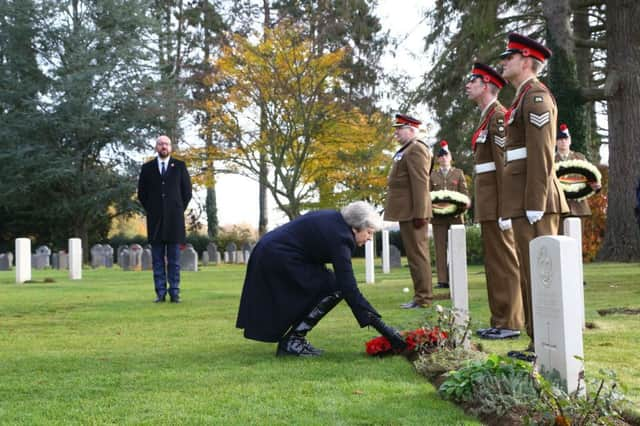May joins Macron to pay tribute to fallen soldiers of WW1


Theresa May travelled to Belgium and France yesterday to take part in a series of engagements alongside French president Emmanuel Macron and Belgian prime minister Charles Michel.
Ending her visit at the Thiepval Memorial, she toured the site – which bears the names of more than 72,000 members of the armed forces who died in battle – accompanied by the director general and interns from the Commonwealth War Graves Commission.
Advertisement
Hide AdAdvertisement
Hide AdIn her second wreath-laying ceremony of the day, she and Mr Macron placed a garland combining poppies and cornflower le bleuet, the two national emblems of remembrance for Britain and France.
On it she left a card with an extract from poem A Soldier’s Cemetery by Sergeant John William Streets which read: “There lie the flower of youth, the men who scorn’d to live (so died) when languished liberty.”
She came to the ceremony from a working lunch with Mr Macron in Albert, the town in the heart of the Somme region which suffered significant bombardment during the conflict. The president was born in nearby Amiens and his British great-grandfather, Bristol-born butcher George William Robertson, fought at the Somme, was decorated for bravery and stayed in France after the war, marrying Suzanne Julia Amelie Leblond in Abbeville in May 1919.
Mrs May began her morning some 80 miles away in Mons visiting the St Symphorien Military Cemetery with Mr Michel.
Set up by the German army, it is the final resting place for British and German soldiers killed at the Battle of Mons.
The pair were greeted by a guard of honour from the Royal Regiment of Fusiliers and stood for the sound of The Last Post before a minute’s silence.
Later they met serving members of the British and Belgian armed forces.
Dressed in a black coat and knee-high patent boots, Mrs May was sombre as she laid wreaths at the graves of Private John Parr of the Middlesex Regiment who died on 21 August 1914 – the first UK soldier to be killed in the conflict – and the last to be killed, Private George Ellison of the Royal Irish Lancers, who died on the Western Front on 11 November 1918 at 9:30am before the Armistice came into effect at 11am.
Advertisement
Hide AdAdvertisement
Hide AdIn the note left by the resting place of Private Parr, Mrs May quoted another line of wartime poetry – The Soldier written by Rupert Brooke.
She wrote: “There is in that rich earth a richer dust concealed.”
The sonnet was written by Brooke, an officer in the Royal Navy, while on leave and formed part of a collection of work entitled 1914 which was published in January 1915.
Brooke never experienced front-line combat and died from blood poisoning on April 23 1915 after being bitten by a mosquito while sailing to Gallipoli. He was buried on the Greek island of Skyros.
At the grave of Private Ellison, also on a headed Downing Street card attached to the garland of poppies, Mrs May wrote: “They were staunch to the end against odds uncounted… We will remember them.”
This was from another poem written by Laurence Binyon and published in September 1914 which is often quoted in Remembrance Sunday services.